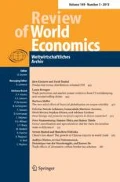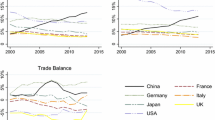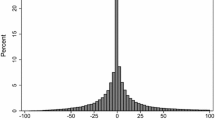Abstract
This paper presents a tabular survey of 147 empirical studies for 39 countries, plus 8 studies for multiple countries, that use transaction level data on exports or imports of firms. I hope this survey is useful for readers who want to get an impression of the huge number of different topics that have been investigated with transaction level data for a large number of countries already; who want to learn whether transaction level data have already been used for a particular (maybe, their own) country, by whom they have been used to investigate which topics, and what the important results found are; who have access to transaction level data and an idea how to use them, and who want to find out whether others pursued the same or a similar topic already; who want to compare results from their own study based on transaction level data to results from other (similar, neighbor) countries and who are looking for suitable studies; who have access to transaction level data and who are looking for studies based on data from other countries that they can replicate with their data to uncover and investigate differences across countries, or to contribute to the unravelling of stylized facts that hold across countries (and time).
Similar content being viewed by others
References
Abreha, K. G., Smeets, V., & Warzynsky, F. (2013). Coping with the crisis: Recent evolution in Danish Firms’ International Trade Involvement, 2000–2010 (Aarhus University Economics Working Papers 2013–15).
Álvarez, R., Faruq, H., & López, R. A. (2010). Is previous export experience important for new exports? (Central Bank of Chile Working Paper 599).
Álvarez, R., & Fuentes, J. R. (2011). Entry into export markets and product quality. The World Economy, 34, 1237–1262.
Álvarez, R., & Sáez, C. (2014). Post financial crisis and exports expansion: Micro-evidence from Chilean exporters (MPRA Munich Personal RePEc Archive Paper 60637).
Amador, J., & Opromolla, L. D. (2010). The margins of exports: Firms, products and destinations. Economics Bulletin (Banco de Portugal), Spring, 103–119.
Andersson, M., Lööf, H., & Johansson, S. (2008). Productivity and international trade: Firm level evidence from a small open economy. Review of World Economics/Weltwirtschaftliches Archiv, 144(4), 776–801.
Arkolakis, C., & Muendler, M.-A. (2013). Exporters and their products: A collection of empirical regularities. CESifo Economic Studies, 59(2), 223–248.
Bastos, P., & Dias, D. A. (2013). The life cycle of exporting firms. Department of Economics, University of Illinois, Urbana.
Békés, G., & Murakösy, B. (2012). Temporary trade and heterogeneous firms. Journal of International Economics, 87, 232–246.
Bernard, A. B., & Jensen, J. B. (1995). Exporters, jobs, and wages in U.S. manufacturing: 1976–1987. Brookings Papers on Economic Activity, Microeconomics, 1, 67–119.
Bernard, A. B., Jensen, J. B., Redding, S. J., & Schott, P. K. (2009a). The margins of US trade. American Economic Review Papers and Proceedings, 99(2), 487–493.
Bernard, A. B., Jensen, J. B., & Schott, P. K. (2009b). Importers, exporters, and multinationals. A portrait of firms in the U.S. that trade goods. In T. Dunne, J. B. Jensen, & M. J. Roberts (Eds.), Producer dynamics. New evidence from micro data (pp. 513–555). Chicago and London: University of Chicago Press.
Bernard, A. B., Moxnes, A., & Ulltveit-Moe K. H. (2014). Two-sided heterogeneity and trade (National Bureau of Economic Research NBER Working Paper 20136).
Bernard, A. B., Redding, S. J., & Schott, P. K. (2011). Multiproduct firms and trade liberalization. Quarterly Journal of Economics, 126(3), 1271–1318.
Bernard, A. B., Van Beveren, I., & Vandenbussche H. (2010). Multi-product exporters, carry-along trade and the margins of trade (National Bank of Belgium NBB Working Paper Series No. 203).
Bernard, A. B., Van Beveren, I., & Vandenbussche, H. (2014). Multi-product exporters and the margins of trade. Japanese Economic Review, 65(2), 142–157.
Blum, B. S., Claro, S., & Horstmann, I. J. (2013). Occasional and perennial exporters. Journal of International Economics, 90(1), 65–74.
Bricogne, J.-C., Fontagné, L., Gaulier, G., Taglioni, D., & Vicard, V. (2010). Exports and sectoral financial dependence. Evidence on French firms during the great global crisis (European Central Bank Working Paper Series No 1227).
Buono, I., & Fadinger, H. (2012). The micro dynamics of exporting: Evidence from French firms (Banca D’Italia Temi di Discussione Number 880).
Casas, C., Díez, F. J., & González, A. (2015). Productivity and export market participation: Evidence from Colombia (Banco de la Republica Colombia, Borradores de Economía Núm 876).
Castellani, D., Serti, F., & Tomasi, C. (2010). Firms in international trade: Importers’ and exporters’ heterogeneity in Italian manufacturing industry. The World Economy, 33(3), 424–457.
Cebeci, T., & Fernandes, A. M. (2015). Microdynamics of Turkey’s export boom in the 2000s. The World Economy, 38(5), 825–855.
Cebeci, T., Fernandes, A. M., Freund, C., & Pierola, M. D. (2012). Exporter dynamics database (World Bank Policy Research Working Paper 6229).
Damijan, J. P., Konings, J., & Polanec, S. (2013). Pass-on trade: Why do firms simultaneously engage in two-way trade in the same varieties? Review of World Economics/Weltwirtschaftliches Archiv, 149(1), 85–111.
Damijan, J. P., Konings, J., & Polanec, S. (2014). Import churning and export performance of multi-product firms. The World Economy, 37(11), 1483–1506.
De Lucio, J., Minguez-Fuentes, R., Minondo, A., & Requena-Silvente, F. (2011). The extensive and intensive margins of Spanish trade. International Review of Applied Economics, 25(5), 615–631.
Duvalaix-Treguer, S., Emlinger, C., Gaigne, C., & Latouche, K. (2015). Quality and export performance: Evidence from cheese industry. In: Paper prepared for the 145th EAAE Seminar Intellectual property rights for geographical indications: what is at stake in the TTIP? 14-15 April 2015, Parma, Italy.
Eaton, J., Kortum, S., & Kramarz, F. (2004). Dissecting trade: Firms, industries, and export destinations. American Economic Review Papers and Proceedings, 94(2), 150–154.
Eriksson, T, Smeets, V., & Warzynski, F. (2009). Small open economy firms in international trade: Evidence from Danish transactions-level data (Aarhus University Department of Economics Working Paper 09-7).
Esteve-Pérez, S., Requena-Silvente, F., & Pallardó-Lopez, V. J. (2013). The duration of firm-destination export relationships: Evidence from Spain, 1997–2006. Economic Inquiry, 51(1), 159–180.
Feenstra, R. C., & Romalis, J. (2014). International prices and endogenous quality. Quarterly Journal of Economics, 129(2), 477–527.
Freund, C., & Pierola, M. D. (2012). Export superstars (The World Bank Policy Research Working Paper 6222).
Gopinath, G., & Neiman, B. (2011). Trade adjustment and productivity in large crises (National Bureau of Economic Research NBER Working Paper Series 16958).
Halpern, L., & Murakösy, B. (2012). Innovation, productivity and exports: The case of Hungary. Economics of Innovation and New Technology, 21(2), 151–173.
Hamermesh, D. S. (2000). The craft of labormetrics. Industrial and Labor Relations Review, 53(3), 363–380.
Iacovone, L., & Javorcik, B. S. (2010). Multi-product exporter: Product churning, uncertainty and export discoveries. Economic Journal, 120(May), 481–499.
Lawless, M. (2009). Firm export dynamics and the geography of trade. Journal of International Economics, 77(2), 245–254.
Lo Turco, A., & Maggioni, D. (2013). CAT exports in Turkish manufacturing. Mimeo. Universitá Politecnica della Marche, Department of Economics and Social Sciences, Ancona.
Manova, K., Wei, S.-J., & Zhang, Z. (2015). Firm exports and multinational activity under credit constraints. Review of Economics and Statistics, 97(3), 574–588.
Manova, K., & Zhang, Z. (2009). China’s exporters and importers: Firms, products and trade partners (National Bureau of Economic Research NBER Working Paper Series 15249).
Martin, J., & Mayneris, F. (2015). High-end variety exporters defying gravity: Micro facts and aggregate implications. Journal of International Economics, 96(1), 55–71.
Melitz, M. J. (2003). The impact of trade on intra-industry reallocations and aggregate industry productivity. Econometrica, 71(6), 1695–1725.
Melitz, M. J., & Redding, S. J. (2014). Heterogeneous firms and trade. In G. Gopinath, E. Helpman, & K. Rogoff (Eds.), Handbook of international economics (Vol. 4, pp. 1–54). Amsterdam: Elsevier.
Muraközy, B. (2012). Margins of Hungarian exports during crisis (EFIGE Working Papers 53).
Muuls, M. (2015). Exporters, importers and credit constraints. Journal of International Economics, 95(2), 333–343.
Muuls, M., & Pisu, M. (2009). Imports and exports at the level of the firm: Evidence from Belgium. The World Economy, 32(5), 692–734.
Rahu, S. (2015). The role of uncertainty for export survival: Evidence from Estonia (The University of Tartu FEBA Working Paper).
Wagner, J. (2007). Exports and productivity: A survey of the evidence from firm-level data. The World Economy, 30(1), 60–82.
Wagner, J. (2012a). German multiple-product, multiple destination exporters: Bernard–Redding–Schott under test. Economics Bulletin, 32(2), 1708–1714.
Wagner, J. (2012b). International trade and firm performance: A survey of empirical studies since 2006. Review of World Economics/Weltwirtschaftliches Archiv, 148(2), 235–267.
Wagner, J. (2012c). Productivity and the extensive margins of trade in German manufacturing firms: Evidence from a non-parametric test. Economics Bulletin, 32(4), 3061–3070.
Wagner, J. (2012d). Trading many goods with many countries: Exporters and Importers from German manufacturing industries. Review of Economics, 63(2), 170–186.
Wagner, J. (2013a). Are low-productive exporters marginal exporters? Evidence from Germany. Economics Bulletin, 33(1), 467–481.
Wagner, Joachim. (2013b). Extensive margins of imports in the great import recovery in Germany, 2009/2010. Economics Bulletin, 33(4), 2732–2743.
Wagner, J. (2014a). A note on quality of a firm’s exports and distance to destination countries: First evidence from German (University of Lüneburg Working Paper Series in Economics No. 302).
Wagner, J. (2014b). Credit constraints and exports: A survey of empirical studies using firm-level data. Industrial and Corporate Change, 23(6), 1477–1492.
Wagner, J. (2014c). Exports and firm profitability: Quality matters! Economics Bulletin, 34(3), 1644–1652.
Wagner, J. (2014d). Is export diversification good for profitability? First evidence for manufacturing enterprises in Germany. Applied Economics, 46(33), 4083–4090.
Wagner, J. (2014e). Low-productive exporters are high-quality exporters. Evidence from Germany. Economics Bulletin, 34(2), 745–756.
Wagner, J. (2014f). The role of extensive margins of exports in the great export recovery in Germany, 2009/2010. Journal of Economics and Statistics, 234(4), 518–526.
Wagner, J. (2014g). What makes a high-quality exporter? Evidence from Germany. Economics Bulletin, 34(2), 865–874.
Wagner, J. (2015a). A note on firm age and the margins of imports: First evidence from Germany. Applied Economics Letters, 22(9), 679–682.
Wagner, J. (2015b). A note on firm age and the margins of exports: First evidence from Germany. The International Trade Journal, 29(2), 93–102.
Wagner, J. (2015c). Credit constraints and margins of import: First evidence for German manufacturing enterprises. Applied Economics, 47(5), 415–430.
Wagner, J. (2015d). Credit constraints and the extensive margins of exports: First evidence for German manufacturing (University of Lüneburg Working Paper Series in Economics No. 336).
Wagner, J. (2015e). R&D activities and extensive margins of exports in manufacturing enterprises: First evidence for Germany (University of Lüneburg Working Paper Series in Economics No. 343).
Author information
Authors and Affiliations
Corresponding author
Electronic supplementary material
Below is the link to the electronic supplementary material.
About this article
Cite this article
Wagner, J. A survey of empirical studies using transaction level data on exports and imports. Rev World Econ 152, 215–225 (2016). https://doi.org/10.1007/s10290-015-0235-8
Published:
Issue Date:
DOI: https://doi.org/10.1007/s10290-015-0235-8




